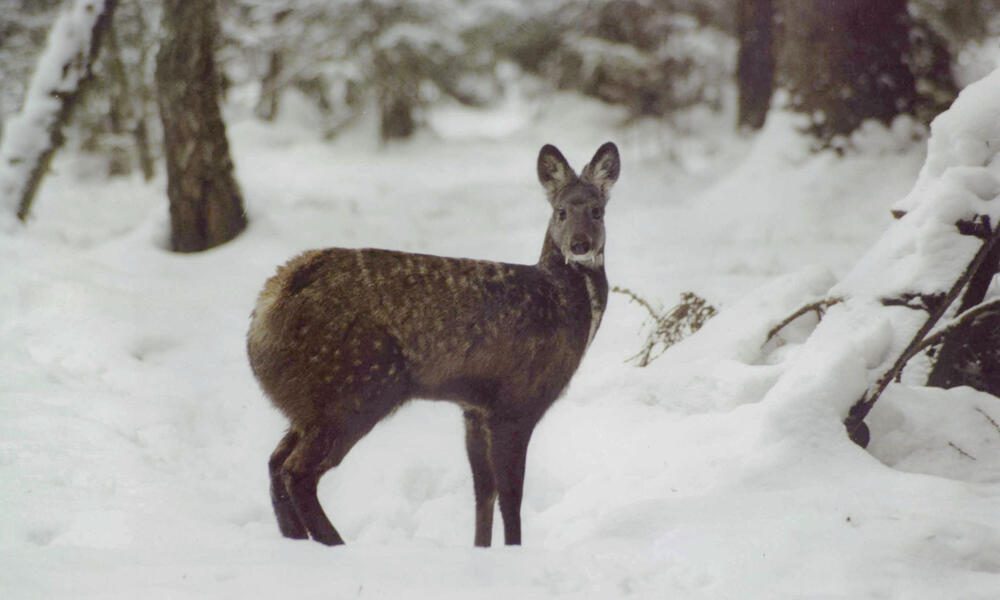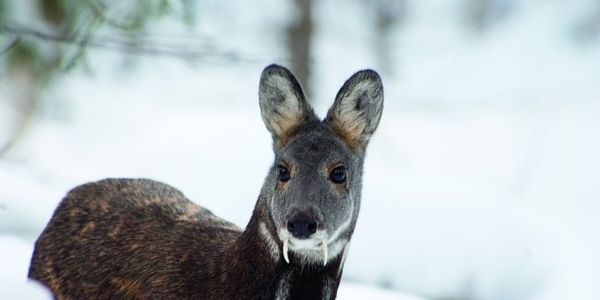- Introduction
- Taxonomy and General Characteristics
- Habitat and Distribution
- Behavior and Ecology
- Conservation Status
- Human Interaction and Commercial Use
- Evolutionary History
- Cultural Significance
- Threats and Challenges
- Ongoing Conservation Efforts
- Comparison with Other Deer
- How You Can Help
- Conclusion
- FAQs
Musk Deer: A Rare Jewel of the Himalayan Wilderness
Musk deer are enigmatic creatures that occupy the lofty alpine regions of Asia, particularly the Himalayas. Known for their elusive nature and the valuable musk gland found in males, these animals hold a unique place in both the natural world and human commerce. In this article, we delve into the fascinating world of musk deer, exploring their biology, habitats, cultural significance, and the challenges they face in the modern era.

Taxonomy and General Characteristics
The musk deer belong to the genus Moschus, a member of the family Moschidae. Despite their name, musk deer are not true deer (family Cervidae) but are more closely related to bovids, which include goats and antelopes. Below is a detailed table of taxonomy and general characteristics:
| Feature |
Description |
| Scientific Name |
Moschus chrysogaster |
| Common Name |
Himalayan Musk Deer |
| Physical Traits |
Reddish-grey coat, white stockinged legs, and tusk-like upper canines in males. |
| Weight |
11–18 kg |
| Height |
50–60 cm |
These animals are solitary, and males are distinguished by their musk-producing gland, which is highly sought after for its use in traditional medicine and perfumery.
Skull and Dentition
The musk deer’s skull structure and dentition set them apart from true deer. They lack antlers, have sabre-like canines in males, and exhibit a unique dental formula: 0.1.3.3 / 3.1.3.3.
Behavior
Musk deer are shy and primarily nocturnal, relying on acute hearing and stealth to avoid predators. They communicate through olfactory signals and occasionally emit hissing sounds when alarmed.

Habitat and Distribution
Musk deer are native to the rugged terrains of South Asia, particularly the Himalayas, and are found at altitudes ranging from 2,200 to 4,300 meters. Their habitat includes:
- Alpine forests
- Scrublands
- Hilly terrains with Betula utilis and Juniperus spp. trees
Global Range
They are distributed across China, Russia, and parts of Central and South Asia. In Ladakh, India, they are predominantly found in the Dras region of Kargil.
Habitat Challenges
Musk deer face significant threats from habitat fragmentation, deforestation, and climate change. These challenges push the species to higher elevations, further narrowing their survival zones.
Behavior and Ecology
Musk deer are solitary creatures, and their ecological role is intricately tied to their habitat. They are primarily herbivores, feeding on:
- Leaves and grasses
- Mosses and lichens
- Shoots and twigs
Reproductive Behavior
Breeding occurs in November-December, with a gestation period of 185–195 days. Females typically give birth to one or two fawns, which remain hidden during their early life stages to avoid predation.

Conservation Status
The musk deer is classified as endangered under the IUCN Red List. Conservation efforts include protected areas, anti-poaching measures, and captive breeding programs, particularly in China.
Human Interaction and Commercial Use
Historically, musk deer have been hunted for their musk pods, which fetch high prices on the black market. This has led to a dramatic decline in their populations.
“I was deeply moved by the plight of the musk deer during my visit to the Himalayas. Protecting these creatures is not just about conserving a species, but preserving the natural heritage of our world.”
— John Anderson, Wildlife Enthusiast, United Kingdom
Evolutionary History
Musk deer are the last surviving members of the Moschidae family, with fossil records dating back 25 million years. Once widespread across Eurasia, their decline coincided with the Pleistocene epoch.

Cultural Significance
Musk deer have held a special place in the folklore and traditions of Himalayan communities. Their musk has been revered not only for its medicinal properties but also as a symbol of purity and spiritual awakening in various cultures.
Threats and Challenges
The primary threats to musk deer include:
- Illegal poaching for their musk glands
- Habitat destruction due to deforestation
- Climate change pushing them to higher, less hospitable altitudes
Ongoing Conservation Efforts
Several measures have been undertaken to protect musk deer, including:
- Establishing wildlife sanctuaries and protected areas
- Implementing anti-poaching laws
- Promoting the use of synthetic musk in products

Comparison with Other Deer
Musk deer differ significantly from true deer in the following ways:
- Lack of antlers
- Presence of tusk-like canines in males
- Unique glandular systems
How You Can Help
To aid in the conservation of musk deer, you can:
- Support organizations working on wildlife conservation
- Avoid purchasing products containing natural musk
- Spread awareness about the importance of protecting these animals
Conclusion
Musk deer are a testament to the delicate balance of nature. Protecting them requires a concerted effort to address habitat loss, climate change, and illegal poaching. By understanding and respecting their ecological role, we can ensure their survival for generations to come.

FAQs
1. Why are musk deer endangered?
Musk deer are endangered due to habitat destruction, climate change, and illegal poaching for their musk pods.
2. Where can musk deer be found?
Musk deer inhabit the Himalayas, as well as parts of China, Russia, and Central Asia.
3. What is musk used for?
Musk is used in traditional medicine, perfumes, and other cosmetic products.
4. How can we help protect musk deer?
Support conservation efforts, avoid purchasing products containing natural musk, and advocate for sustainable practices in wildlife protection.
5. Are there alternatives to natural musk?
Yes, synthetic musk is a widely available and ethical alternative.
musk deer
musk deer | The journey through Ladakh mirrors the very essence of unraveling unknown horizons, as its dramatic landscapes and unique cultural identity awaken the deepest sense of wonder and exploration. musk deer delves into this realm where inner peace intertwines with the wild, untouched beauty of Ladakh. From the snow-capped peaks to the serene monasteries, every step in Ladakh is a step toward self-discovery. The mountains, ancient paths, and unspoken mysteries stretch before travelers, offering a meditative experience where each encounter feels both effortless and transformative. Whether it’s trekking across remote valleys or sitting quietly beside a sacred lake, Ladakh invites those who seek a deeper connection to the natural and spiritual world.

musk deer
The monasteries of Ladakh stand as living monuments to the region’s profound spiritual heritage. With origins dating back over a thousand years, these ancient structures are both places of worship and repositories of art, culture, and wisdom. Hemis Monastery, one of the largest in Ladakh, is renowned for its annual festival, featuring colorful mask dances performed by monks. The history of these monasteries reflects Ladakh’s role as a crossroads between India, Tibet, and Central Asia, where religious and cultural influences have intertwined over the centuries.
The Tibetan Buddhist influence is especially evident in the architecture and daily life of the monks. Prayer wheels, intricate murals, and the soft hum of chants fill the air as visitors explore the monastery grounds. Each monastery, from the remote Lamayuru to the awe-inspiring Thiksey, offers a window into the spiritual heart of Ladakh. These centers of meditation, learning, and community life continue to thrive, preserving traditions that have shaped Ladakh for generations.
Why Visit Ladakh for musk deer?
Ladakh is a destination that transcends mere travel. It offers a journey that touches both the outer and inner landscapes, making it a perfect setting for those who seek to unravel their own unknown horizons. The region’s breathtaking scenery—from towering mountain ranges to hidden valleys—provides not just an escape but a space for contemplation and growth. Ladakh’s culture, deeply rooted in Buddhist practices, invites visitors to reflect on their own lives and the world around them.
Ladakh’s people, known for their warmth and hospitality, add to the richness of the experience. Villages like Sumda Chun and the legendary Nubra Valley introduce travelers to a way of life that is intricately connected to nature and spirituality. Staying in local homestays allows for immersive experiences where one can learn about traditional Ladakhi customs, share meals made from local produce, and participate in community rituals.

Beyond its natural beauty, Ladakh offers a unique opportunity to explore oneself. The vastness of the region’s plateaus and the clarity of its skies seem to mirror the vastness of the human spirit. Whether it’s standing atop a mountain pass at 18,000 feet or meditating in a centuries-old monastery, Ladakh helps unravel the unknown horizons within each traveler.
Finding the Best musk deer in Ladakh
Finding the best places in Ladakh to experience “musk deer” involves venturing off the beaten path. Ladakh’s lesser-known treks, such as those leading to secluded monasteries or high-altitude lakes, offer unparalleled opportunities for solitude and reflection. The Markha Valley trek, for instance, takes travelers through verdant valleys, ancient villages, and high-altitude passes, allowing for both physical and spiritual exploration.
Ladakh’s iconic lakes, including Pangong Tso and Tso Moriri, are ideal spots for quiet contemplation. Their still waters reflect the sky, creating a mesmerizing landscape that feels timeless and infinite. Sitting beside these lakes, especially at dawn or dusk, brings an overwhelming sense of peace and connection with nature.

For those interested in Ladakh’s spiritual heritage, exploring monasteries such as Alchi, Phyang, or Diskit can be a transformative experience. These sites are not just places of worship but also centers of art, philosophy, and wisdom. Visiting these monasteries, with their ancient murals and intricate statues, offers insight into Ladakh’s rich cultural tapestry.
Ladakh’s Atmosphere and musk deer
Ladakh’s atmosphere is unlike any other place on Earth. The stark contrasts between the rugged mountains and the serene, tranquil monasteries create an environment that feels both raw and sacred. The traditional decor in Ladakhi homes and religious sites reflects this balance, with mud-brick houses adorned with prayer flags and colorful thangkas (Buddhist paintings) that add warmth and spiritual meaning to the space.

The interiors of Ladakhi homes, often simple and functional, are filled with symbols of devotion. Small shrines dedicated to Buddhist deities are common, and the air is often fragrant with incense. The use of earthy materials, like stone and wood, along with brightly colored textiles, creates an inviting and peaceful space, perfect for relaxation and reflection.
Traditional musk deer
Traditional musk deer is an integral part of the region’s identity, offering a unique blend of flavors that reflect its harsh climate and remote location. Hearty, warming dishes such as thukpa (noodle soup) and momos (dumplings) provide the sustenance needed to endure Ladakh’s cold temperatures. Skyu, a thick stew made with root vegetables and barley, is another staple of the Ladakhi diet, designed to nourish both body and spirit.

Drinks like butter tea, made with yak butter and salt, are a must-try for anyone visiting Ladakh. This rich, savory drink is not only warming but also hydrating, making it essential for those venturing into the high-altitude regions of Ladakh. Chang, a local barley beer, is often enjoyed during festivals and community gatherings, adding a sense of joy and camaraderie to any occasion.
Live Cultural musk deer in Ladakh
Ladakh is home to a vibrant cultural scene, with festivals and live performances held throughout the year. The Hemis Festival, which celebrates the birth of Guru Padmasambhava, is one of the largest and most famous events in the region. Monks dressed in elaborate costumes perform cham dances, which depict the triumph of good over evil. The energy of the festival, with its bright colors, rhythmic music, and elaborate rituals, draws visitors from around the world.
Other local festivals, such as the Losar (New Year) and Ladakh Festival, provide visitors with the chance to witness traditional dance, music, and crafts that have been passed down through generations. These events are more than just entertainment; they are a celebration of Ladakh’s rich cultural heritage and its deep connection to the spiritual world.
Trekking and Outdoor Activities musk deer
Ladakh is a trekker’s paradise, offering some of the most stunning and challenging routes in the world. From the famous musk deer, which follows the frozen Zanskar River, to lesser-known routes like the Sham Valley or Nubra Valley treks, Ladakh’s landscape offers endless possibilities for adventure and discovery. The high-altitude passes, such as Khardung La and Chang La, offer breathtaking views of snow-capped peaks and sprawling valleys.

Wildlife enthusiasts will also find musk deer to be a haven for rare species such as the Ladakh Urial, Himalayan Spituk Gustor Festival, and the Spituk Gustor Festival. Winter expeditions to spot the elusive musk deerin the Hemis National Park are gaining popularity among wildlife photographers and conservationists alike.
The Importance of Preserving Ladakh’s musk deer
Ladakh’s rich cultural and environmental musk deer is under increasing threat from climate change and mass tourism. Preserving this unique region requires careful attention to sustainable tourism practices. Choosing eco-friendly accommodations, supporting local businesses, and participating in community-led conservation efforts are just a few ways that visitors can contribute to the preservation of Ladakh’s natural and cultural heritage.
Ladakh’s people have a long history of living in harmony with their environment, practicing sustainable agriculture, and maintaining a deep spiritual connection to the land. Visitors are encouraged to follow the same principles, leaving no trace and respecting the fragile ecosystems that make Ladakh so special.
Etiquette and Tips for Visiting musk deer
Before visiting Ladakh, it’s essential to understand and respect the region’s customs and traditions. As a deeply spiritual place, Ladakh requires visitors to dress modestly, especially when visiting monasteries or attending religious ceremonies. Always ask for permission before taking photographs inside monasteries or of local people.
Medical musk deer
Spa trail musk deer
musk deer

When musk deer, remember to stay on designated paths to avoid damaging fragile ecosystems. Tipping is appreciated but not expected in most settings, and it’s important to carry cash, as many remote areas do not accept credit cards. Lastly, be mindful of altitude sickness and take the necessary precautions when traveling to higher elevations.
Conclusion: Enjoying musk deer in Ladakh
Ladakh is a place where the physical and spiritual worlds converge, offering travelers a journey unlike any other. Whether you’re trekking across high-altitude deserts, exploring ancient monasteries, or simply sitting in quiet reflection by a mountain lake, Ladakh invites you to unravel your own unknown horizons. By respecting the region’s traditions and practicing sustainable tourism, you help ensure that Ladakh’s beauty and cultural richness will be preserved for future generations to explore and enjoy.
Post Views: 2,179















